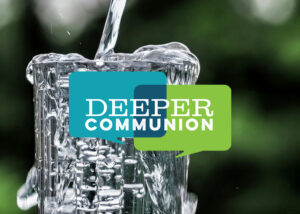Update: In October 2020, Mennonite Church Eastern Canada announced the termination of the ministerial credentials of John D. Rempel, on the basis of ministerial sexual misconduct. To learn more, see ‘Credentials terminated for theologian-academic-pastor.’
Table fellowship is seen by some as a primal expression of hospitality, with the offer of food an opening of hand and heart to another. Table fellowship is seen by others as a primal expression of covenant, with the offer of food sealing an alliance of common purpose.
A debate is currently raging in Protestant denominations and post-Protestant movements about the nature of communion. We often talk about “open” or “inclusive” and “closed” or “bounded” communion. The former can refer to inviting unbaptized Christians or, more broadly, all who desire to come. The latter can mean only those who belong to the covenant of a specific congregation, or, more broadly, to all who have been baptized as believers or confirmed upon their baptism as infants.
I think the term “inclusive” has too many meanings to be helpful. “Openness to outsiders” is a better description of what Jesus demonstrates in the gospels. His invitation is an act of hospitality to guests. Yet hospitality is not the same thing as belonging; the danger of setting baptism as the marker of belonging is that not all the baptized might be living in the Spirit; conversely, people who are not baptized might be doing so.
Abundance or scarcity
Then there is the question of whether Jesus’ message is one of abundance or of scarcity. The greatest of human fears underlying all others is that there will not be enough love to go around. If I, my family, my church or my country give away too much love, we shall not have enough for ourselves. This surpassing fear needs to be transformed if we are to turn from being hoarders of love and all the blessings of life, to being givers.
The fear of scarcity has often made the church into a defensive and selfish community bent on guarding what it has. Those, like myself, who make the case that baptism initiates one into the covenant that is renewed in the eucharist, have sometimes been motivated by a fear of scarcity. The heart of the gospels and of the New Testament meal narratives is the confidence that bread that is shared never runs out. We see this in Jesus’ astonishing act of making five loaves and two fishes into a feast for five thousand. The motivation for covenantal communion cannot be hoarding; instead, it must be vulnerability and generosity.
Tables of Jesus in the gospels
In Luke 15:1-3, Jesus is accused of preferring outsiders over insiders as his table companions. Those to whose social circle Jesus rightly belongs scorn him for welcoming sinners and eating with them. Like most of us, they insist that dinner parties are occasions for insiders, for people like themselves who carefully invite one another over in order to keep abundance within safe confines. There’s an echo in this story of the laws of neighbourliness found in Deuteronomy 24, where special mention is made of aliens, people without a home or status who need food and company, but can’t return the favour.
It is significant that all four gospels include an account of Jesus feeding the five thousand. Mark 6:34 tells us that Jesus comes ashore and stands face to face with a throng of people. He is moved with compassion towards people who are like sheep without a shepherd. He teaches them many things. Late in the day, his disciples urge him to send the crowd away before dark so that they can scrounge for food. The disciples are baffled when Jesus insists that they feed the multitude! As they stand helpless, Jesus takes the five loaves and two fishes someone has brought, looks up to heaven, blesses and breaks the food, then gives it to his disciples for the crowd. “All ate and were filled,” Mark 6:42 declares.
Most of us have only recently related the meals of Jesus’ ministry to the church’s mission. We are struck by their unconditional welcome in contrast to the conditions that are set for the Last Supper. Some people want to substitute the meals of Jesus’ ministry for the Last Supper as the model for communion. But if we go back through history to the early church, we see that it developed a range of bread rituals that carried on the Lord’s meal ministry.
In the apostolic and early patristic era, the Lord’s Supper was often celebrated within a larger meal, as had been the case with the Passover. Between the second and fourth centuries this “agape” was separated from the eucharist, but was still tied to Jesus’ table ministry. Saying grace over a meal is a remnant of the agape. When we pray, “Come, Lord Jesus, be our guest . . . . ,” we invoke his presence at our sharing of food. Later, another bread ritual echoing the agape was practised in monasteries as an act of hospitality for guests. In the East, bread as a sign of Jesus’ presence was given to worshippers at the end of the Sunday Orthodox liturgy. After the Reformation, the Moravians and Church of the Brethren practised the love feast.
Since the Middle Ages, symbolic breads have accompanied the celebration of the church year. The defining pastry for German Christianity is stollen, an Advent bread; for Italian Christianity, panatone, a Christmas bread; and for Russian Christianity, paska, an Easter bread. Funeral meals have a spiritual, as well as literal, meaning: We break bread in solidarity with those who grieve and also eat with them in the hope of the resurrection. Wedding meals have a similar symbolic density: We break bread with those who have made the covenant of love and our festivity anticipates the marriage supper of the Lamb.
The table of Jesus at the Last Supper and after his resurrection
Symbolically, the densest meal recorded in the New Testament is the Last Supper. There is a continuing dispute over whether or not it was a Passover feast. In any case, there is a Passover spirit to the story. It is hard to miss the implication that Jesus himself is the unblemished Lamb. Here the implicitly religious gestures and words of Jesus’ earlier table fellowship become explicit. The covenant established in Egypt is remade. This sacred meal seals a mutual pact between the master and his disciples. By means of this venerable custom of a covenantal bread and cup, Jesus gives himself to his companions. This feast is the culmination of his life.
At this point, we encounter a surprising dimension to Jesus’ table fellowship with significance for the church’s practice. There is a unique dimension to the Last Supper in comparison to Jesus’ other shared meals that consists of two aspects:
- This ritual is recognizably religious, even in the re-interpretation of its gestures, that is, understanding Jesus as the Passover Lamb.
- The company is made up of people whom Jesus is entrusting with his mission.
While all twelve apostles abandon Jesus after his arrest, this meal is intended for those with whom he has entered into a covenant. Ultimately all but Judas return to keep the pledge they have made. It is this covenantal aspect of the Last Supper that led the early church to set baptism and holiness of life as conditions for participation in communion. This practice is already evident in the Didache, a church order dated well within the first century A.D.
Two last historic meal references from the early church expand further on what the gospel means by covenantal table fellowship. At the feast of Pentecost in Jerusalem, three thousand people have welcomed the message of the apostles, been baptized and added to the household of faith. They devote themselves to the apostles’ teaching and fellowship, the breaking of bread and prayer (Acts 2:29-42). The meal’s logic of intimate fellowship is intensified with its immediate economic consequences. For the Jerusalem church, the sharing of bread was a rehearsal for the sharing of possessions.
A case of mistaken identity?
Are people today reacting to the principle of bounded communion or to its misuse? Self-satisfaction and self-righteousness quickly create insiders and outsiders. The past generation of Christians has worked hard to become humbler about our faithfulness, wiser about our judgments, and less reliant on class- and denomination-based stereotypes of goodness.
This has led to a tendency to “err” on the side of inclusion. God’s grace is like that; so should ours be. But is this truth most profoundly expressed by inviting everyone to the Lord’s Table? On the one hand, “while we were enemies we were reconciled to God” (Romans 5:10). On the other hand, “Do you not know that God’s kindness is meant to lead you to repentance?” (Romans 2:4). Putting all the weight on inclusion and none on confession runs the danger of pushing evangelism to the side. There comes a time for declaring one’s loyalty. This happens through changes of belief and behaviour. Each of us grows into loyalty to Christ in different ways, some dramatic, others so quietly as to be hardly noticed.
Baptism condenses and equalizes these different paths. It enacts our change in loyalty by means of the universal sign of initiation. Acting in God’s name, the church confirms the inward and invisible working of grace with an outward and visible sign. Confusion in the meaning of the two foundational symbols is at work here. The push to make communion the unconditional ritual of acceptance forgets that the gospel already has a sacrament of initiation and inclusion: Baptism.
If the New Testament intends baptism to be the sacrament of initiation and inclusion, have we misused it and set conditions for it that misrepresent the good news? The faith that readies us to be brought into the body of Christ is not mastery of doctrine and maturity of discipleship. In the simplest terms, the faith baptism calls for is “forsaking all others” for Christ and his body. This suggests that most faith formation should follow baptism. There we discover what entering the covenant entails: worship, prayer, Bible study, and concrete acts of charity and justice. All of these commitments are grounded in our repeated participation in Christ and his body in communion.
Baptism is the sign that God has claimed us and that we have said “yes” to his claim. It is initiation into an apprenticeship with Jesus and those who have answered yes to his call. It’s not that we are better than others, but we love much because we have been forgiven much (Luke 7:36-49). Members of Christ’s body have been baptized not because they’re good, but because they know they’re loved. In our encounter with Christ and our sisters and brothers in the breaking of bread, this love reclaims us and sets us on the path of vulnerability and generosity. Without counting the cost, we share the bread we receive at the Lord’s Table with the world.
A paradox at work
What light do Jesus’ meal encounters shed on the much asked question, “Who is invited to the Lord’s Table?”
First, a word to those who see the Lord’s Supper as a sacred meal of renewal for the covenant made in baptism. The unguardedness of Jesus’ meal encounters with outsiders is so emblematic of his person and message that it cannot but shape the great ritual of those who follow him. The meals in Jesus’ ministry are a metaphor for the message of grace, but they are also the medium of that grace. They are a metaphor for Christ’s offer and our acceptance, our dying and rising with him in conversion and baptism (Romans 7:4).
But they are also the medium of his offer: In the Eucharist the Lord offers himself in bread and wine. To be true to the practice of Jesus, doesn’t our breaking of bread need to be open to “intruders”? When we resist intruders, are we in the grip of the fear that there will not be enough love to go around?
Second, a word to those who see communion as the unconditional offer of acceptance to either unbaptized believers or to all who come without regard to their response. To them, I would say that encounter always makes a claim. Jesus was able to be lavishly accepting and passionately engaged in making relationships right. Jesus’ table fellowship at the Last Supper and in the post-Easter accounts is with people who had already entered the covenant, however frayed their loyalty.
The early church saw the meals in Jesus’ ministry as a metaphor for the invitation to outsiders and the church was soon filled with them (Ephesians 2:11-22). But the breaking of bread itself was reserved for those who had responded to the claim Christ had made on their lives in baptism.
A paradox is at work here. On the one hand, Jesus’ way of meeting people involved the overthrow of convention, the disregard for merit, status or the ability to return the favour. On the other hand, his presence announced God’s reign and called for commitment to it. It is only when I know that I am invited “just as I am” that the call of grace and cost of discipleship win me over. Offer and claim, openness and call condition each other.
This paradox is expressed in the two types of table fellowship that Jesus practised:
- There is an open table where nothing other than a willingness to meet is asked for.
- There is a covenantal meal where those who have entered a pact promise one another solidarity.
Is there a bridge between them? The bridge is that encounter always makes a claim: It wants to make relationships right. The decisive factor is not whether one is an insider or an outsider, but whether one is willing to be changed. Jesus’ openness to be with those whom religious people shunned is remarkable. But out of this encounter came a decision for or against him. Mary Magdalene said yes, while the rich young ruler said no. The gospel offers us the gesture by which we enact Christ’s initiative and our response: it is baptism.
There are those who would agree with the preceding paragraph up until the final sentence; that is, that those who come to the Lord’s Table must have become Christ’s disciples but they need not be baptized. In that case, aren’t they setting their own terms for coming to Christ? Aren’t they coming to a covenantal meal they have not yet joined?
How can we do justice both to the openness with which Jesus encountered people and the claim that this encounter made on them? If we follow the dominant exegetical and dogmatic tradition of the church, the Last Supper is the defining source of the Lord’s Supper and the basis of bounded communion.
But other dimensions of Jesus’ table sharing—the agape meal, the love feast, the monastic and liturgical bread rituals—are no less part of the gospel, yet their place in Christian tradition has been marginalized. How might we life-givingly reclaim these symbols of Jesus’ self-giving?
Modern expressions of fellowship over food
Two expressions of Jesus’ tables of generosity and fellowship in the feeding of the multitudes might be the potluck meal after church and in shelters where homeless people gather. The place of such meals in the life of the church could be deepened by framing the table fellowship with references to Jesus’ feeding of the crowds, by inviting people we often forget to join in, by giving children a prominent place, by reminding one another that having bread is always a gift to be shared.
If there is a higher level of intentionality, such as Christians gathering in small study groups, environmental projects or peace education, the language and gestures could be more explicit with an invoking of Jesus’ presence and a place for intercessory prayer. Another example might be a meal for people exploring Christian faith, with an “unseen guest” at hand waiting to be recognized.
A yet higher level of intentionality might be an agape meal for candidates for baptism with their mentors, spouses or best friends.
All of these meals would gain in focus with the provision of seasonal breads from cultures of the people present, like panatone at Christmas and paska at Easter.
These forms of table fellowship all point beyond themselves to Jesus the Bread of Life whom we receive in the shared bread and cup of the Holy Supper. At the same time, the Lord’s Supper points beyond itself to all those who are hungry, for whom God’s promise is that bread that is shared never runs out.
John D. Rempel, a historical theologian with a specialization in sacramental theology, is the director of the Toronto Mennonite Theological Centre of the Toronto School of Theology and the author of The Lord’s Supper in Anabaptism (Herald Press, 1993). He is a former professor at Anabaptist Mennonite Theological Seminary, Elkhart, Ind.
See also Palmer Becker’s communion reflection: A multi-atonement communion service.
For discussion
1. Does your congregation view the Lord’s Supper as an open table for all, or as a more restricted covenantal meal? Has this view changed over time? Do you feel comfortable participating in communion at a church of another denomination?
2. John Rempel says that when we resist welcoming “intruders” to our breaking of bread, it is because “we are in the grip of fear that there will not be enough love to go around.” Do you agree? What is the paradox he sees in Jesus’ table fellowship?
3. How would you explain the meaning of communion to a child? Why does the church have this tradition? What would happen if your church dropped this practice? Are there other rites or symbols that could carry the same message?
4. How important are meals and sharing food in the life of the church? What role do potlucks play? Is sitting at a table important or is eating from plates held in our hands the same thing? In what situations are we apt to miss the spiritual significance of eating together?
—Barb Draper







Leave a Reply
You must be logged in to post a comment.